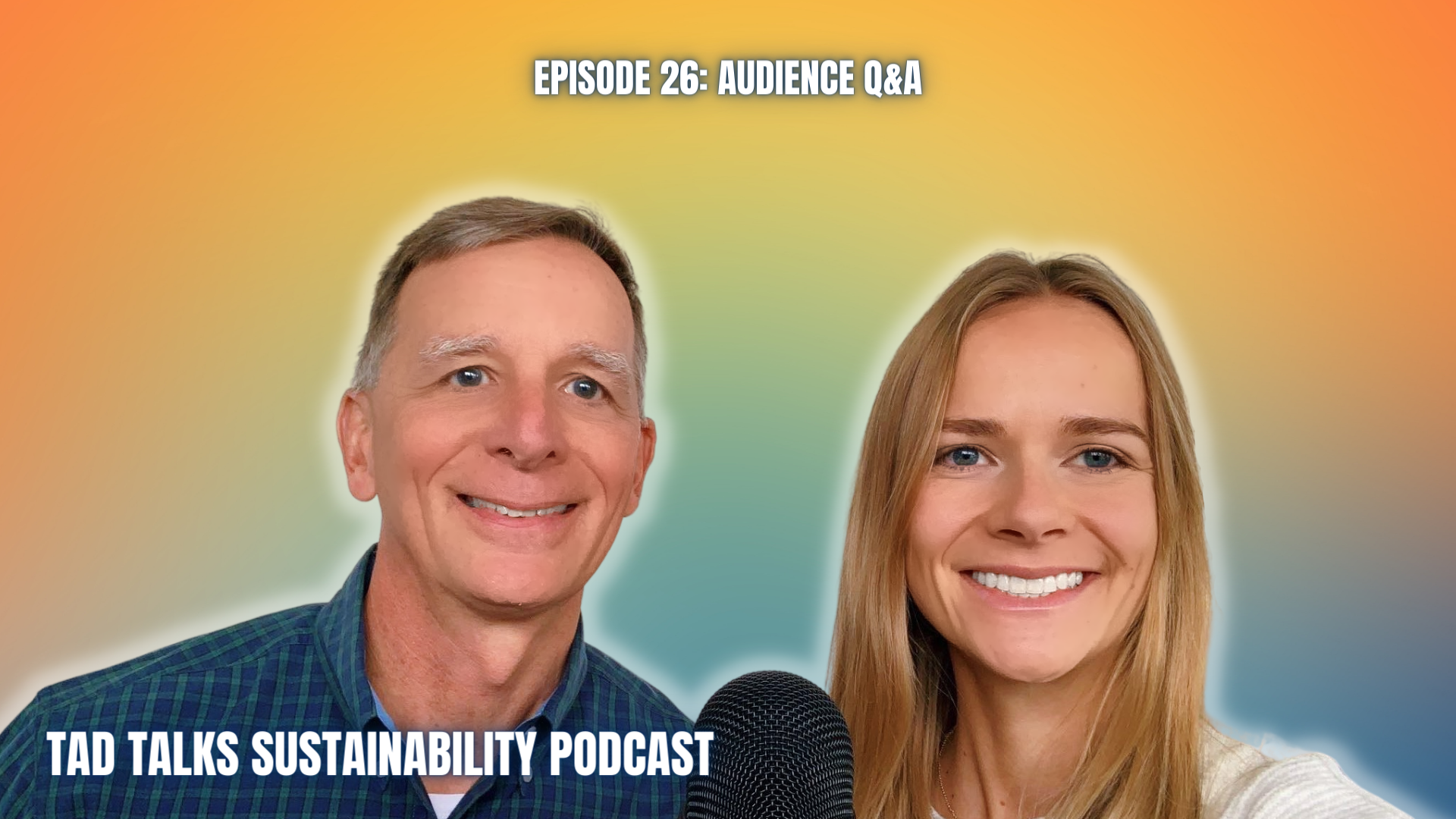Episode 26: Audience Q&A
Click the links below to listen to the full episode
You asked, we answered! In this episode, Tad and Julianna discuss a few of the anonymous questions we have received from our audience. The audience questions that we answer in this episode include:
My company doesn't know what to do first, should we do our carbon footprint benchmarking or a life cycle assessment?
My company is trying to understand how we should do our Scope 3 analysis. Do you have any suggestions on how to approach this?
How can I calculate greenhouse gas emissions for an LLDPE plastic poly bag using virgin resin? Then how can I calculate the reduction by using a 90% post-consumer resin in the same product?
What's more important for manufacturers to prioritize: Environmental Product Declarations (EPDs) or Health Product Declarations (HPDs)?
With so many certifications in the marketplace, how does a consumer quickly educate themselves on what products are certified? What are the differences in what a certification looks at and what certification represents my beliefs?
As an end consumer, what are some sustainability efforts I can take on my own and in my own house?
Interested in submitting a question for Tad to answer on an upcoming episode? Type your question into the box at the bottom of the page!
Question 1: my company doesn't know what to do first, Should we do our carbon footprint benchmarking or do a life cycle assessment?
ANSWER 1:
“That's a question we get quite often. The way I would answer this is if you're going to do a life cycle assessment, you're going to be collecting a lot of the information that you would have to do for your carbon footprint benchmarking anyway. So what I tend to suggest to people is to think about if you need the life cycle, and what you want to qualify. Many companies are like, “Oh, should I just do a life cycle assessment just to get an environmental product declaration?” And that's fine, but we strongly recommend companies to do life cycle assessments so they can understand the impacts of their product, manufacturing, raw materials, transportation, etc. Then they can use that information to plan out their whole decarbonization strategy as they move forward as well.
They can also use it for their new product development with their R&D teams and their folks that are working in their stage gate processes to analyze the various products and create the next generation products. So my answer would be, if you're thinking about doing both, you could do the life cycle assessment because you are going to be collecting the scope one and scope two emissions data. Just to remind everybody, scope one is all the fuels you burn in your facility and operations. You're also going to be doing your scope two, which would be all the electricity you use. So right there you would be doing your carbon footprint benchmarking. Let's say that you're running a life cycle assessment on the products that are manufactured, that would then give you the metric around your carbon footprint benchmarking.
So you would know, for every product you make, it's X kilowatt hours of electricity, it's Y MMBtu of natural gas or, the scope one, scope two. So then you have a metric to actually then set goals. By doing the LCA, you're really going to be accomplishing a lot. The beautiful thing about the LCA also, is it would help you to do your scope three emissions because you would then have an understanding of the impacts of the raw materials you're using, which could be a very large part of your scope three. So my advice, do the life cycle assessment, but also in parallel flesh out what you need to do for your carbon footprint at the same time, because you're going to be collecting the same data and then you get multiple uses for setting your goals, driving more sustainable products, and also maybe doing some of your scope three..”
Question 2: my company is trying to understand how we should do our scope three analysis. Do you have any suggestions on how to approach this?
ANSWER 2:
“Well, the question I just answered is a great lead into this. Scope three means it's all the emissions that you have some responsibility for but you do not own. For example, let's say you're a manufacturer of products and you're buying raw materials or you're buying parts and you're assembling something and then selling it. All the suppliers that are sending you the raw materials or the parts, have their own carbon footprints. Basically their scope one and scope two emissions for making them raw materials and parts and then getting them over to you. So that is one thing that you have to think about. What we do find is anybody that manufactures anything, usually the raw materials and their suppliers, are the largest part of their footprint. So that is one aspect to consider here.
Like I said earlier, if you do a life cycle assessment, you can definitely start to understand the carbon footprint of those raw materials and parts because you would have your LCA data from the ecoinvent Database or the USLCI database from the LCA software that would allow you to estimate that. That would probably be a big chunk of your scope three. However, scope three could also be the transportation of those raw materials to your plant because you usually don't own the trucks that are bringing that in or the ships that are bringing in the materials. Then it would also be the transportation of your final product from your factory gate out to distribution and to sale. Because usually you're using a third-party to do that, a supplier for that transportation service.
Another aspect would be the waste that you generate and even though you generate the waste, you don't manage it. So the waste that goes to the landfill, the waste that goes to the recycling center, the compost facility, the waste to energy facility, those are all managed by somebody else, but those emissions you have, you're responsible for because you created the waste. Other things could be employee travel, if you lease buildings, there's all kinds of different things you'd have to look at. What I would say here is you want to identify what would be the category of scope three that's probably most impactful. Make that assessment and try to determine. If you're a manufacturer, it's probably gonna be your raw materials and those transportations I just mentioned, depending on what you manufacture, it could be waste also. So those would be great places to start, start looking at what are the categories that are most relevant to you and then in many cases there's not a perfect science for doing scope three. So there'd be a lot of estimating and calculations and there are methodologies you can follow on how to do the calculations that are accepted practice. So that would be my recommendation on how to approach scope three..”
Question 3: what's more important for manufacturers to prioritize, Environmental Product Declarations (EPDs) or Health Product Declarations (HPDs)?
ANSWER 3:
“I'd have to look at the product but the thing I'd be thinking about is, what is the demand by the market? I can tell you right now that they're both important documents and an Environmental Product Declaration discloses the environmental impacts of a product. Whereas, a Health Product Declaration is looking at the material ingredients and the associated hazards or of those various chemicals and materials that are in the product. There has been a major shift though for a while. Health Product Declarations were really in big demand. Now, if you want to do any kind of business, let's say these are building products or even you're selling into the federal government, the Environmental Product Declaration, I think would have a lot more importance right at this minute.
So if you had to make a choice, what do I do first? I would probably say do the EPD first, because that will give you multiple benefits. You're not just doing the EPD just to get points in a green building standard or meet a government purchasing requirement, but you then can use that life cycle data to really figure out how to make the product more sustainable. You could also use it to maybe decide on setting up goals for your decarbonization strategy or your sustainability goals. When you're doing the EPD analysis, you will be diving deep to understand the raw materials. So you could almost do it in parallel if you wanted, where you start to collect some data and information about each of the chemicals that goes in and run those through a hazard screen. Then you could be ready to do an HPD in parallel to doing the EPD. So that might be a good way to approach it. But I would say that at least from my perspective, I'm seeing a lot more demand for the Environmental Product Declarations than compared to the Health Product Declarations.”
WE’RE ANSWERING QUESTIONS FROM OUR AUDIENCE!
Anonymously ask Tad a question about sustainability by typing your question in the box below.
We will answer your questions on an upcoming episode.





